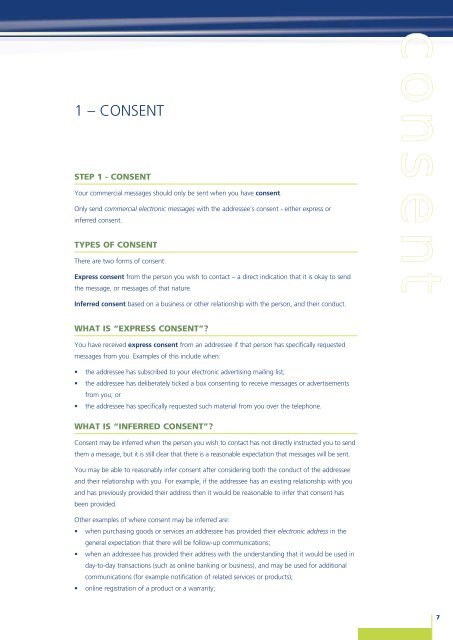Spam Act 2003: A practical guide for business
sTG2H
sTG2H
Create successful ePaper yourself
Turn your PDF publications into a flip-book with our unique Google optimized e-Paper software.
1 – CONSENT<br />
STEP 1 - CONSENT<br />
Your commercial messages should only be sent when you have consent.<br />
Only send commercial electronic messages with the addressee’s consent - either express or<br />
inferred consent.<br />
TYPES OF CONSENT<br />
There are two <strong>for</strong>ms of consent:<br />
Express consent from the person you wish to contact – a direct indication that it is okay to send<br />
the message, or messages of that nature.<br />
Inferred consent based on a <strong>business</strong> or other relationship with the person, and their conduct.<br />
consent<br />
WHAT IS “EXPRESS CONSENT”?<br />
You have received express consent from an addressee if that person has specifically requested<br />
messages from you. Examples of this include when:<br />
• the addressee has subscribed to your electronic advertising mailing list;<br />
• the addressee has deliberately ticked a box consenting to receive messages or advertisements<br />
from you; or<br />
• the addressee has specifically requested such material from you over the telephone.<br />
WHAT IS “INFERRED CONSENT”?<br />
Consent may be inferred when the person you wish to contact has not directly instructed you to send<br />
them a message, but it is still clear that there is a reasonable expectation that messages will be sent.<br />
You may be able to reasonably infer consent after considering both the conduct of the addressee<br />
and their relationship with you. For example, if the addressee has an existing relationship with you<br />
and has previously provided their address then it would be reasonable to infer that consent has<br />
been provided.<br />
Other examples of where consent may be inferred are:<br />
• when purchasing goods or services an addressee has provided their electronic address in the<br />
general expectation that there will be follow-up communications;<br />
• when an addressee has provided their address with the understanding that it would be used in<br />
day-to-day transactions (such as online banking or <strong>business</strong>), and may be used <strong>for</strong> additional<br />
communications (<strong>for</strong> example notification of related services or products);<br />
• online registration of a product or a warranty;<br />
7


